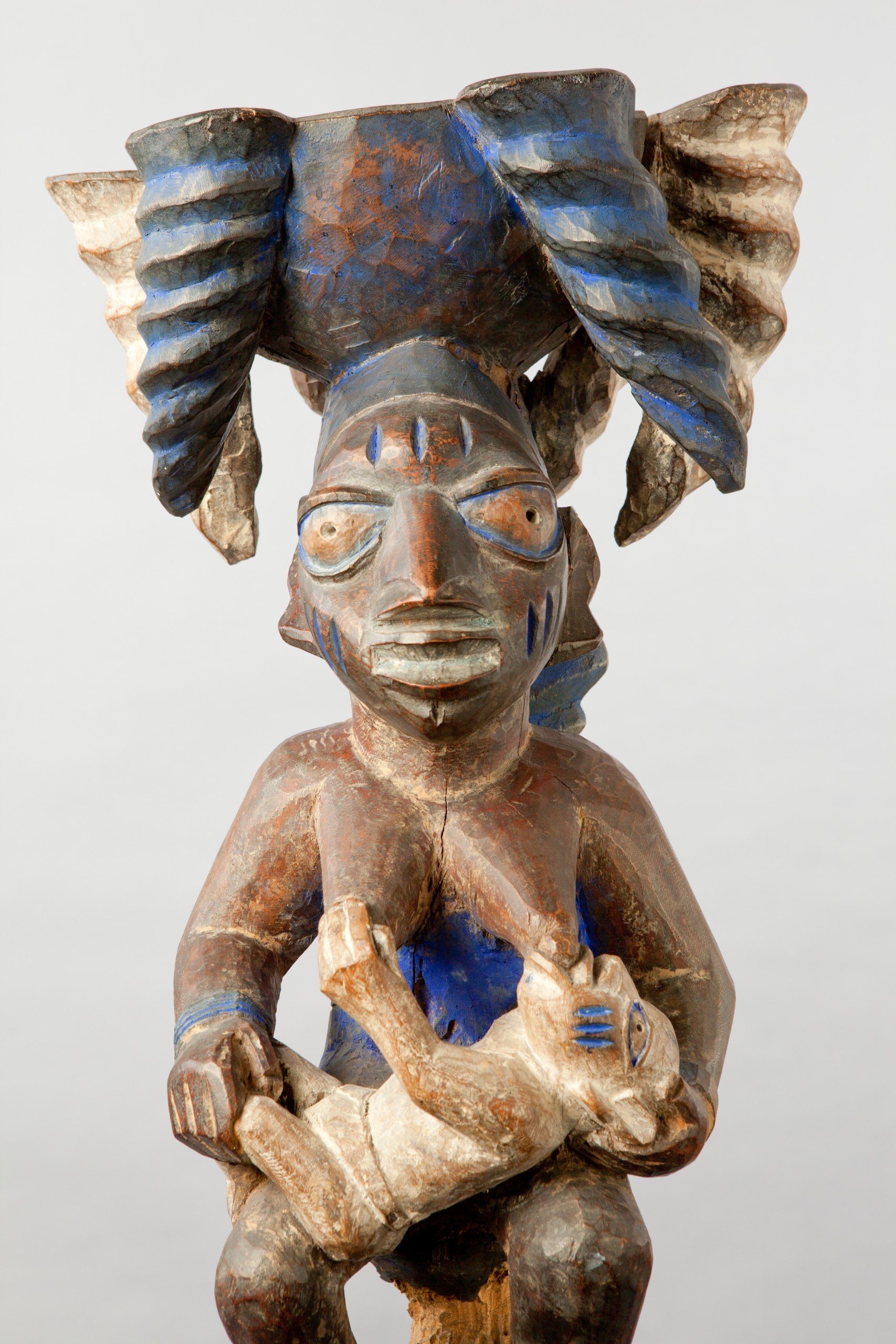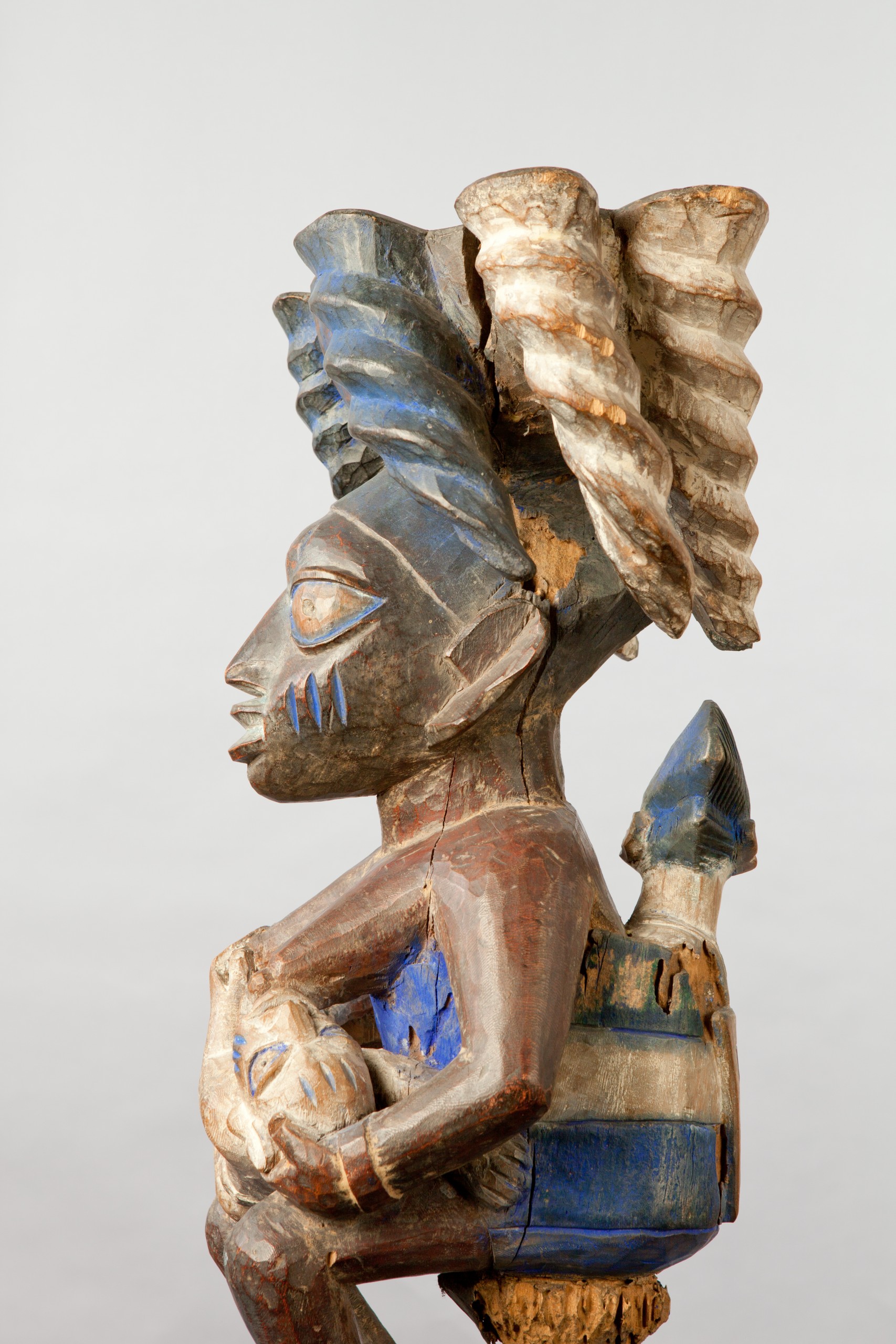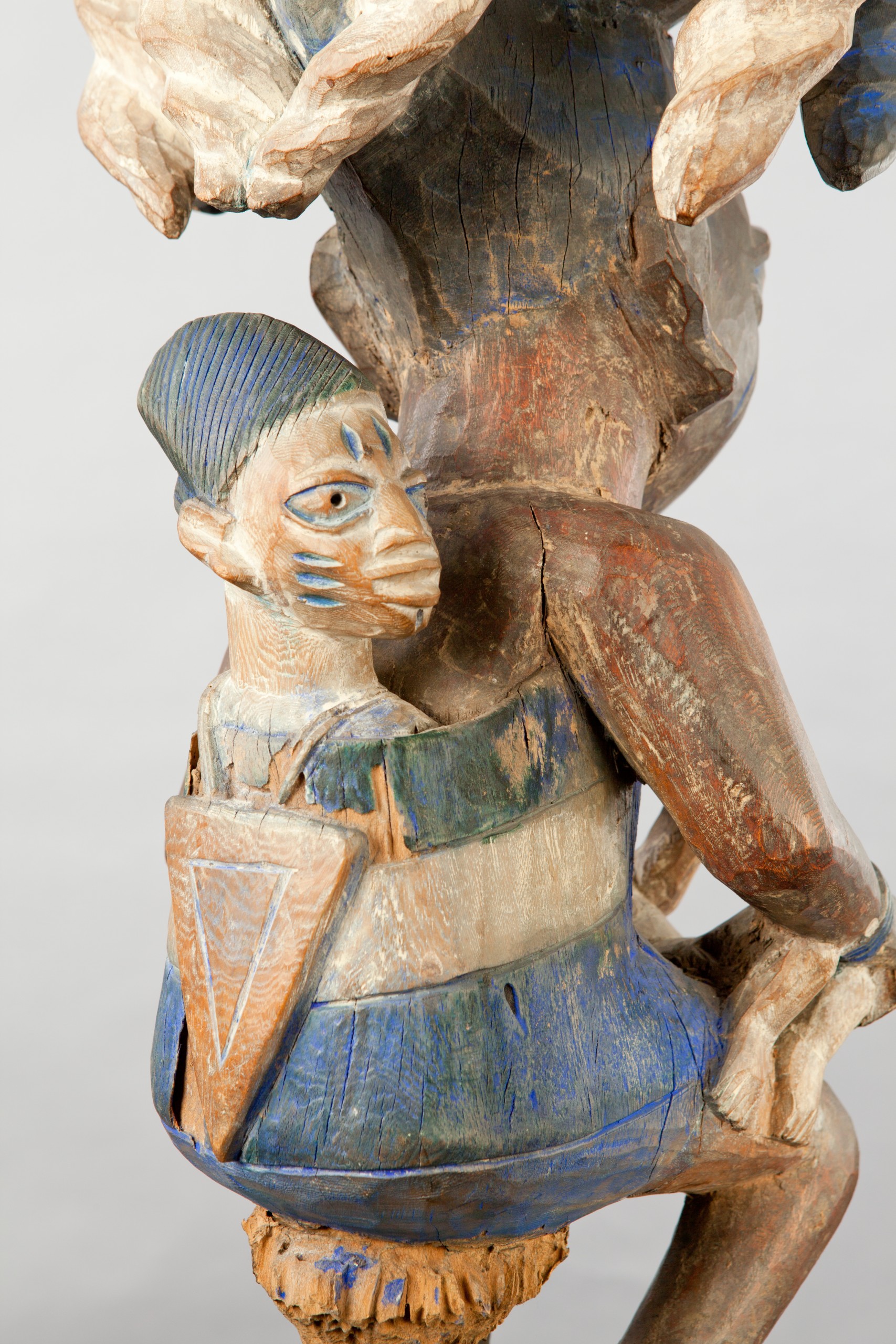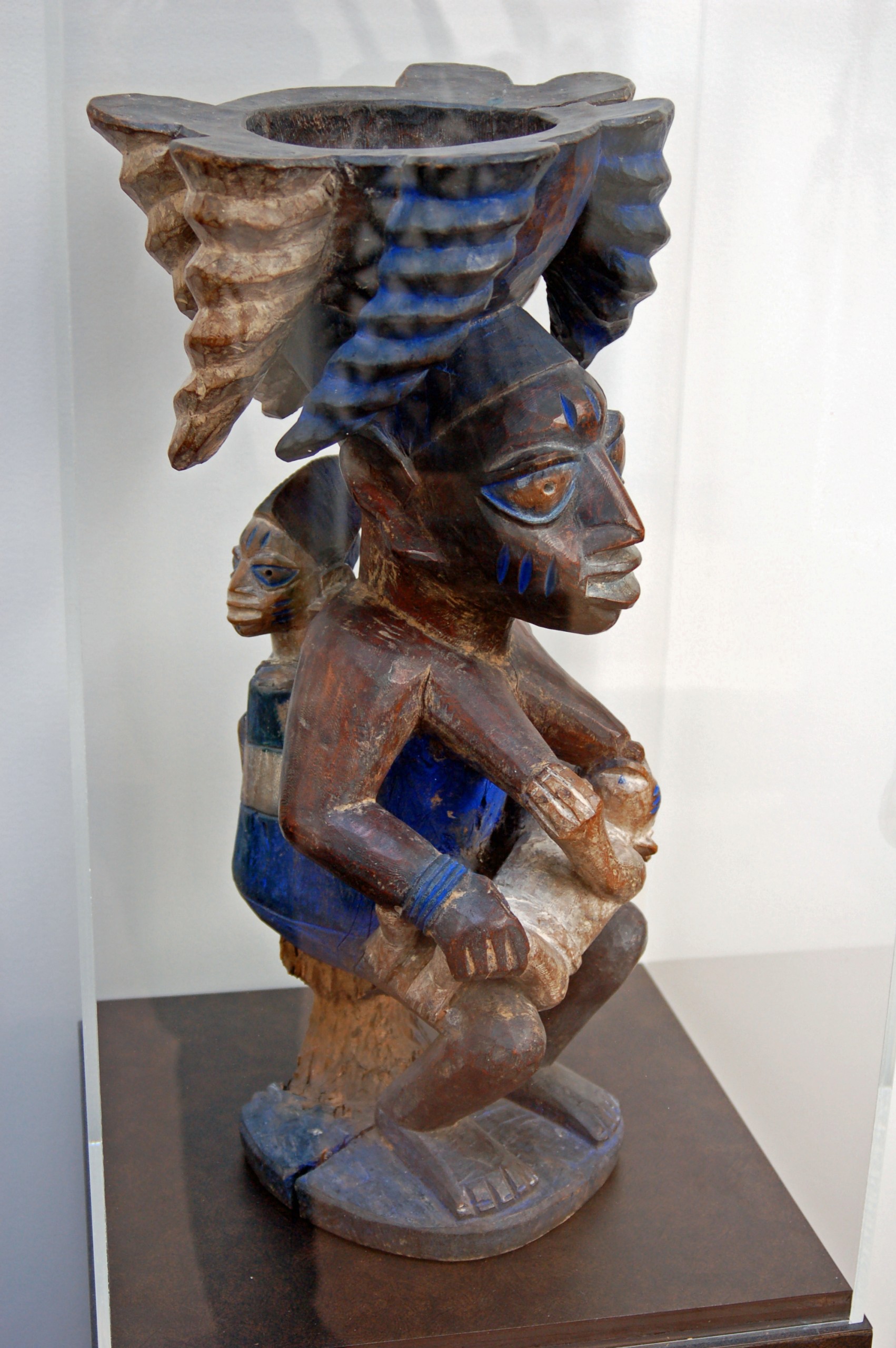Learn More: Yoruba Agere Ifa
This wooden sculpture, created by an unknown Yoruba artist from Nigeria in West Africa, depicts a kneeling maternal figure with a nursing child in her arms, while carrying another child on her back. Figures created in this form are commonly called agere ifa. This term refers to any carved container that is used to store the sacred palm nuts that are an important element in the Yoruba ritual of divination. This figure balances a carved bowl on top of her head, which is where the palm nuts would be stored during the ritual.
The mother figure was carved in its entirety from a single piece of wood. (The traditional stages of Yoruba woodcarving can be seen in Fakẹyẹ 60-61.) Generally the artist left the body unpainted, however the facial features, clothing, and the container on top of the figure’s head are emphasized with visible traces of white and blue color. The artist also emphasized this feature of the figure through the use of color and the decorative elements of the container; along the outside of this bowl are carved, spiral forms, which are alternatively decorated with white and blue pigment. Additionally, the exterior of the bowl itself is emphasized because traces of the same blue pigment remain.
The artist accentuated the figure’s facial features with the application of the paint: the large eyes are outlined with blue pigment and on each of the cheeks and forehead three lines have been incised, and filled in with the same blue pigment. These same marks are also incised into the cheeks of child that she holds in her arms; the child carried on her back only has these marks on its forehead. These are marks of scarification, which was a common practice among many kingdoms of pre-colonial Nigeria, including the Yoruba. To create these marks on the human body, lines were incised into the skin, and left untreated for permanent scars to appear. The design of the scarification marks served as an indication of ethnic and lineage identities, and was usually performed during infancy (Pitt Rivers Museum Body Arts; Ojo 368-369).
It is also indicated that the figure wears a garment on her lower half because this section is painted blue, and is differentiated from her bare extremities by incised lines. The artist left the mother’s conical-shaped breasts bare with the child suckling on her left breast, while grasping the other with its left hand. The child carried on the figure’s back appears to be in a sling made of alternating bands of blue and white color. This is embellished with a triangular-shaped wood piece. It is indicated that this piece rests on top of the colored bands because it projects slightly from the sling. However, it is integrated into the sculpture by two slimly carved strips that attach to the top of this piece, and wrap around the child’s neck. This child’s arms, which are painted dark blue, and its legs, painted white, wrap around the female figure.
The most apparent difference between the children and the mother figure is that on their skin remnants of pigment can be observed on the faces and extremities. Some of the mother figure’s facial features are not emphasized by paint, but characterized by geometric shapes. The bridge of the figure’s nose has a parabolic shape: the edges slightly taper inwards between the eyes, and are connected by a curved line between the eyelids. At the bottom of the nose, the bridge comes to a sharp point in the center, which defines the semi-circle shaped nostrils. The nostrils have been formed by carving this shape into either side of the nose bridge. Additionally, the mouth has a rectangular form, but the bottom of each of the lips curves downwards. The figure’s ears resemble the shape of half-hearts, which reflects the shape and angle of the top of the figure’s head.
While the mother figure’s face remains in good condition, some parts of the sculpture display deterioration. Just behind the figure’s left ear is a large crack in the wood, which extends from the lip of the bowl to the base of the figure’s neck. The figure sits on a roughly carved stool that is decorated with irregular drops of blue and white pigment. The stool is connected to the base of this piece, which is the most fragmented part of the figure. Behind the figure’s right foot, a crack runs from the edge of the base to the bottom of the stool. However, the other side of the base is in a poorer condition: about a quarter of the base has deteriorated likely due to insect damage.
Even though this figure is not in perfect condition, this sculpture illustrates the honored role of Yoruba women as mothers. In Yoruba art tradition, mother figures are commonly depicted as nursing, holding, or surrounded by one or more children because motherhood and the ability to create new life are highly honored. Additionally, this mother figure serves as an example of how the idealized gender dynamics of the Yoruba are commonly portrayed in art. Overall, male and female Yoruba have complementary gender relations, which are fluid rather than fixed. Therefore, one gender is not seen as dominant over the other, but one gender may be more prominent in certain contexts. In the artistic context, males are traditionally much more prominent than females. Especially in the art of woodcarving, which is considered the most important art form among the Yoruba.
Among the Yoruba, seniority in social status and age are seen as dominant and deserving of respect, which is shown in a kneeling posture. This posture expresses respect and submission, which women take when they greet their husbands, their elders, or their deities. A figure’s kneeling position is meant to recognize the seniority and social position of the one who is kneeled before.
Above all, the Yoruba people express respect and submission to their deities (orisha). Individuals will honor the orisha with votive objects in designated shrines. The Yoruba believe that when they die, their souls enter the realm of the ancestors and still have influence on earth. Therefore, they annually pay homage to the shrine of their forbearers as well. Yet, the most important of the Yoruba deities is Oduduwa, the ancestor of all people. According to their oral tradition, the Yoruba origin myth describes Oduduwa’s descent to Earth and creation of their original kingdoms. Oduduwa is said to have brought a rooster, some earth, and a single palm kernel. He took the earth and threw it into the water, and land was created when the rooster scratched at this earth. From this land, the palm kernel grew into a tree with sixteen limbs, each of which represented one of the original sixteen Yoruba kingdoms (“Art & Life in Africa: Yoruba”).
Nevertheless, the deity that is most relevant in divination is Ifa, the God of Divination. Yoruba people specifically ask Ifa for guidance in making a decision or facing a problem, because they believe that Ifa acts as an intercessor between all of the orisha and humans (Mullen 21-22).
During the divination ritual, the diviners, known as Iyanifa (mothers who own Ifa) and the Babalawo (fathers of the secret) act as the intercessors between a Yoruba individual who seeks this guidance, and Ifa. The Babalawo are male diviners, who have usually been trained by their fathers who were also diviners. Once a male becomes a Babalawo, they have the same social advantages as the political leaders, because they know the myths, songs, riddles, proverbs, magic and rituals of their people (Olajubu 57-59; Mullen 25).
The female diviners, Iyanifa, are not as numerous or as common as Babalawo in Yoruba communities. Generally, this is because few women are able to balance their domestic and maternal duties with their Ifa training. Thus, Ifanifa commonly choose to marry a Babalawo and practice in a partnership with them. The Yoruba people see the Iyanifa as the true caretakers of tradition, and for this reason only the Babalawo, who match their cultural knowledge and influence are worthy of marrying them (Olajubu 58-59).
Just as the gender of the diviner may vary, the instruments and ritual itself vary between Yoruba communities. Yet, typically included are sixteen palm nuts, which are stored in an agere ifa. Aside from depicting maternal figures, the other common iconography of these bowls includes female devotees to the orisha, animals (particularly roosters), and equestrian figures.
The focal object of the ritual is the wooden divination tray, which is usually round and covered with powdered wood. During the ritual, the main task of the diviners is to interpret the marks made in the powdered wood coating the divination tray. Based on the marks the diviner creates, he or she will recite one of sixteen pre-determined verses of Yoruba oral literature, odu. Often these verses suggest further rituals or sacrifices that the diviner’s client should take part in to resolve their problem (Ross).
To create each of these instruments of divination, an artist must acquire stylistic knowledge of his craft. The term àṣà generally describes the traditions of a group of Yoruba people over a period of time. However, it may also be applied to the creation of artwork, where it relates to the accumulation of styles: an individual’s artistic àṣà results from the collection and combination of creative styles from a diverse range of locations and sources. Generally, the most well-known Yoruba woodcarvers travel a lot around Nigeria, so they are exposed to styles and work of artists beyond the immediate environment in their formation of their personal àṣà (Abiodun 17; for a biography of a successful Yoruba woodcarver, see Fakẹyẹ).
In this way, the creation of art by Yoruba artists is not static, even though it historically appeared this way to Western eyes. In the past, Western art historians crafted a myth of anonymity among African artists because these artists would not sign their work. This led these art historians to believe that African artists simply repeated traditional motifs, and did not integrate their own style.
Today, this Western myth has dissolved, and the unique authorship of work is recognized. Nevertheless, artists are often only known by nicknames to scholars. Partially this is because in this culture, an individual’s given name is closely associated with his or her personality, and is believed to determine the failure or success of one’s actions. Calling this full name is thought to bring one’s personality to surface, and cause the individual to act according to the meaning of his or her name, or in a way that the caller desires them to (Abiodun 18). “By reason of their profession and position in the traditional community” the Yoruba saw artists as “especially vulnerable…to malevolent forces” when their full names are called (Abiodun 19). Artists’ full names are not only associated with their personalities and their success, but also with their artistic and personal àṣà. For this reason, the artist’s full name may not have been shared with a scholar.
In some cases, such as this figure, the artist’s name may be unknown, and there may not be enough visual evidence to identify this individual’s hand. African artists may differentiate their authorship through their style, personal àṣà. Artists will also specialize in specific sculptural forms, which becomes another way to recognize the authorship of a piece.
To learn the skill of differentiating the authorship of a piece, one must train with elders who are experts in the traditional artistic procedures and desirable aesthetics. Essentially, through this training one becomes an art critic and can distinguish “well made” work. The Yoruba believe that if an artist has a beautiful mind, this beauty will translate into their execution of their art. Therefore, to create aesthetically “well done” work, one must have an honorable personal íwà, which requires a specific worldview: recognizing and respecting the uniqueness in everyone and everything. Only then can an artist tap into his creative íwà, which is employed to create “well made” work according to the art critics (Abiodun 22)
– Kelsey Barnes ’16, Anthropology & Art History
Sources
Abiodun, Rowland. “African Aesthetics.” Journal of Aesthetic Education. Vol. 35, No. 4 (2001): 15-23.
Drewal, Henry John, John Pemberton, Rowland Abiodun, and Allen Wardwell. Yoruba: Nine Centuries of African Art and Thought. New York: Center for African Art in association with H.N. Abrams, 1989.
Fakẹyẹ, Lamidi Ọlọnade, Bruce M. Haight, with David H. Curl. Lamidi Ọlọnade Fakẹyẹ: My Life and My Art. Holland, MI: Hope College, 1996.
Mullen, Nicole. “Yoruba Art & Culture.” Phoebe A. Hearst Museum of Anthropology: University of California, Berkeley (2004): 1-35. http://hearstmuseum.berkeley.edu/sites/default/files/teacher-resources/TR_YorubaArtAndCulture.pdf
Ojo, Olatunji. “Beyond Diversity: Women, Scarification, and Yoruba Identity.” History in Africa Vol. 35 (2008): 347-374. http://dh101.humanities.ucla.edu/DH101Fall12Lab5/archive/files/6f07ed7e83f23b50361292fb627d4c9a.pdf
Olajubu, Oyeronke. “Seeing through a Woman’s Eye: Yoruba Religious Tradition and Gender Relations.” Journal of Feminist Studies in Religion Vol. 20, No. 1 (2004): 41-60.
Omari-Obayemi, Mikelle S. “An Indigenous Anatomy of Power and Art: A New Look at Yoruba Women in Society and Religion.” Dialectical Anthropology Vol. 21, No. 1, Nigeria (1996): 89-98.
Pitt Rivers Museum Body Arts. “Scarification in Nigeria.” Pitt Rivers Museum. http://web.prm.ox.ac.uk/bodyarts/index.php/permanent-body-arts/scarification/179-scarification-in-nigeria.html
Ross, Doran H. “8. Divination Instruments.” Oxford Art Online. Last modified 2015. http://www.oxfordartonline.com.w.ezproxy.nypl.org/subscriber/article/grove/art/T000675pg14?q=Divination+Instruments&search=quick&pos=1&_start=1#firsthit
University of Iowa Museum of Art. “Art & Life in Africa: Yoruba.” http://africa.uima.uiowa.edu/peoples/show/Yoruba
University of Iowa Museum of Art. “Art & Life in Africa: Status of the Diviner.” http://africa.uima.uiowa.edu/chapters/divination/status-of-the-diviner/






